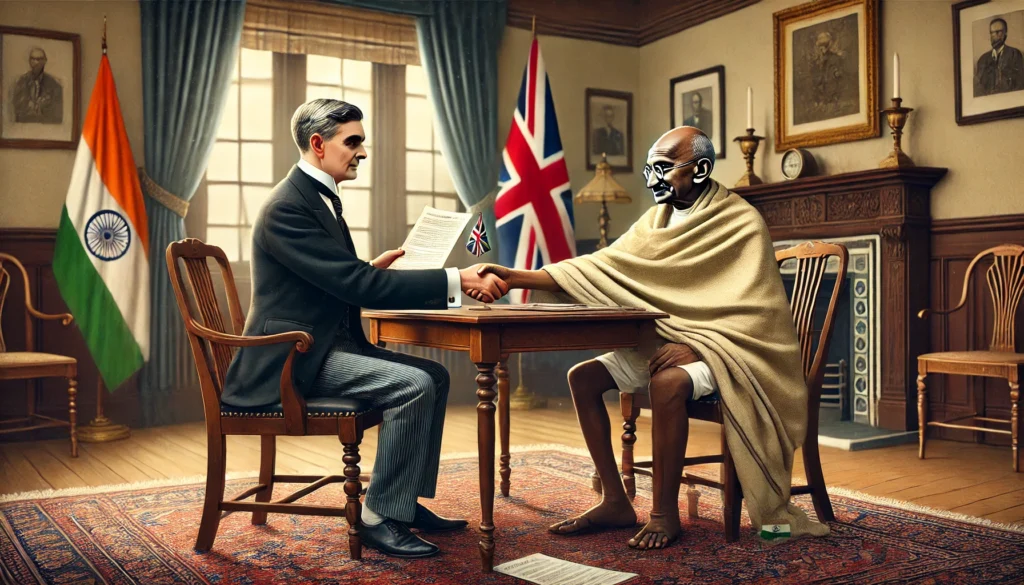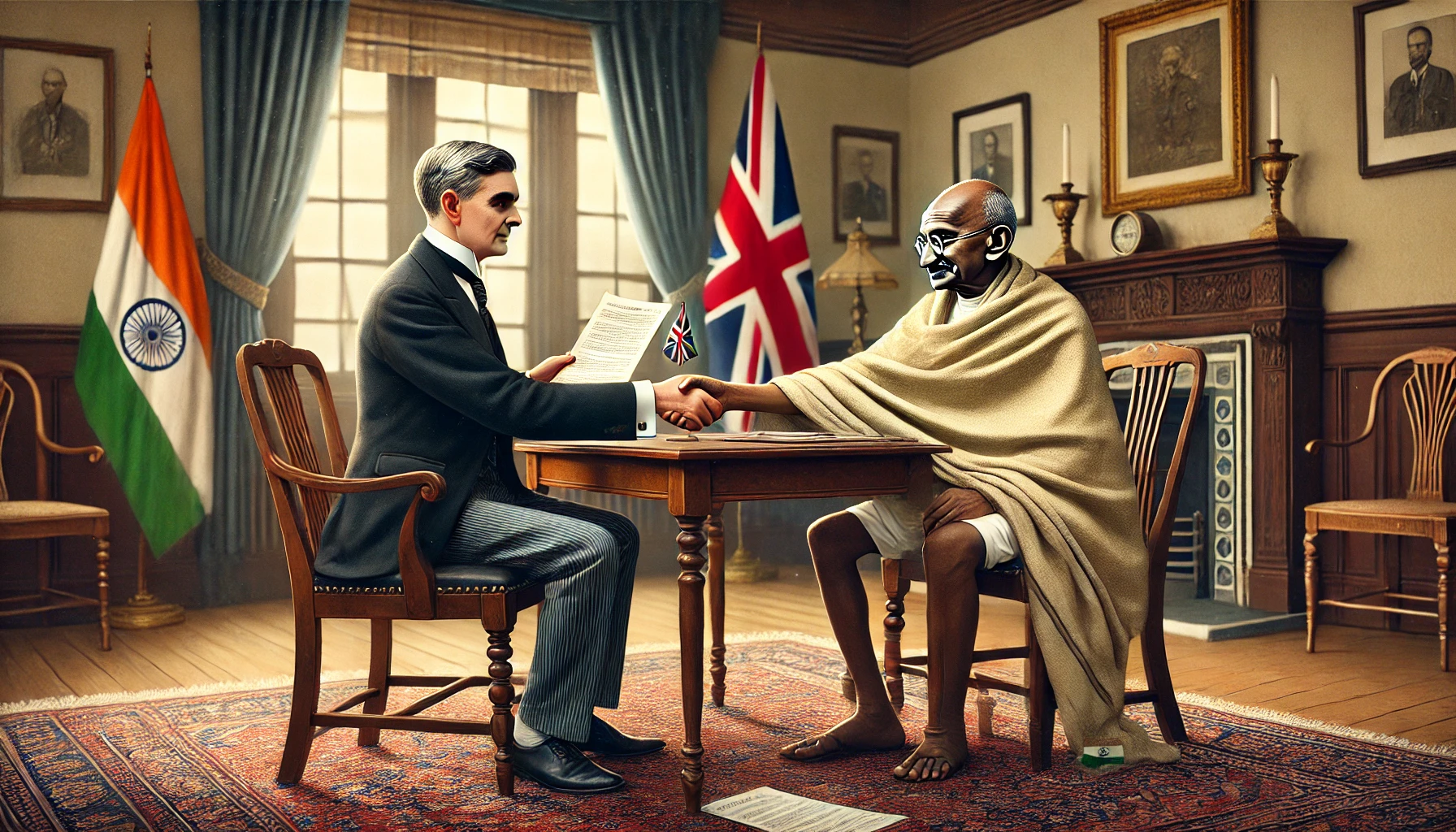The Gandhi-Irwin Pact of 1931: A Critical Analysis in India’s Movement toward Freedom
Gandhi-Irwin Pact
It was on 5th March 1931, when the British Viceroy, Lord Irwin was able to reach an understanding with the Indian National Congress’ leader Mahatma Gandhi. This was actually an important juncture during the Indian freedom movement eventually leading to the way into the Second Round Table Conference in London.
It was an attempt at relief on the part of the British government in order to diffuse tension between itself and the Indian nationalist movement, at the peak of which stood the person of Gandhi when he organized his Civil Disobedience Movement in 1930.

Background Leading to the Pact
Civil Disobedience Movement was begun on 12th March, 1930 due to Salt March organized by Gandhi in defiance of the British monopoly over salt which had wider implications for opposing British rule.
It was extremely popular in India when people openly challenged the colonial laws by boycotting British goods, refusing to pay taxes and breaching other restrictive rules.
Severe repression from the British government, imprisonment of thousands of freedom fighters included Gandhi and brutally suppressed the movement.
Role of Lord Irwin and British Concerns
He also feared this surging unrest and economics of the boycott on the trade by Britain.
British, under the pressure of global economic crises, mainly post the Great Depression, was making Indian rule a pricey affair.
The British sought to drag the Indian leadership onto the negotiating table while reducing the populaces to further the revolutionary movements which threatened to loosen the empire’s grip over India.
Bargaining and Major Reasons for the Agreement
Gandhi was released in January 1931 after negotiating with Lord Irwin.
The driving forces were relief for political prisoners for Gandhi and the Congress so that Indians could exercise certain civil rights and advance India’s own demands for political reforms
Bargaining and Major Reasons for the Agreement
Retreating the Civil Disobedience Movement:-
Gandhi accepted the withdrawing of the active movement of the Civil Disobedience to offer for a warm and cooperative atmosphere.
Political Prisoners Freed:-
Britain agreed to grant freedom to political prisoners jailed during the movement except those found guilty of causing violent activities
Ease Picketing Peacefully:-
British Government permitted peaceful picketing for Indians so that they might picket against the British items and facilities.
Salt Monopoly and Coastal Collection Rights:-
Britain agreed to grant Indians remaining along the coast their rights of collection and manufacture of salt for their personal consumption, and that was the concession made on the salt acts, half.
Return of usurped property:-
British also promised to return land and other movable properties usurped from persons who participated in the Civil Disobedience Movement. They did this on the pretext that they were not violent.
Revoke the Ban on Congress Action:-
The convention led to the removal of ban on Indian National Congress who were compelled to work illegally; it was again given a license to function with transparency
Promise of More Reforms in the Future:-
However, not part of this treaty, a broad commitment was made that future constitutional reform would be under consideration was made by Irwin,
Response to the Pact
Indian National Congress:-
Most of the members of Congress, particularly radical politicians like Subhas Chandra Bose, thought that this treaty would not work since it was too soft and weak towards the British to get independence.
Public Mind and Freedom Fighters in India:-
People received mixed reactions. Some appreciated the steps it was taking towards freedom; however, others felt disappointed as no complete freedom was achieved overnight.
British Government:-
To the British, this treaty was a political act, which would dampen the revolt intensifying at that point and the British government’s portrayal as cooperative.
Gandhi’s Role in Round Table Conference II
The Fruit of the Treaty came as an invitation to Indian National Congress leadership at the Second Round Table Conference held in London in September 1931, one of its kind.
The conference was called with a view to discussing the future of India’s constitutional framework and terms and conditions of possible self-government within the British Empire.
It did not succeed in producing concrete agreement as the British were too stiff, and full dominion status was turned down by the British.
Criticisms and Limitations of the Pact
No Tangible Gains to Indians:-
Critics pointed that the agreement did not touch fundamental issues like full freedom, constitutional amendments, and even complete abolition of black laws.
Unfulfilled Expectations:-
The British government frustrated the Congress by not releasing all the political prisoners on their terms with the lowest possible salt tax concessions.
Strategic Vulnerability:-
It is perceived as an onslaught to the Civil Disobedience Movement, which is the most potent form of national resistance.
Lack of Revolutionary Elements Most of the revolutionary groups opposed the pact, and this included Bhagat Singh’s followers. They felt that their sacrifices were belittled and a moderate approach that would not give full independence to India was being promoted.
Impact of the Gandhi-Irwin Pact on India’s Freedom Struggle
Consolidation of Support:-
The agreement was for the first time the British realized that the Indian National Congress is a negotiating power and would, therefore add the legitimacy of it to be the representative for Indians.
It could present a point that India was ready to fight harder and can extract concessions from the British, thus keeping strengthening India’s spirit of taking on the task of not giving up independence. Boost to Indian Nationalist Morale.
Inspiration to Future Treaties:-
All the negotiations and diplomatic contacts by Indian leaders with the British after it were inspired from this treaty, and thus subsequent treaties were signed and deals were forged during the freedom struggle period.
British Policy Change:-
The treaty showed that British government was ready for negotiation. However, this treaty as well as successive conferences of the time reflected that Britain was not yet ready for complete independence for India which made the demand of India more aggressive in nature.
Legacy and Historic Importance of the Gandhi-Irwin Pact
A success of the non-violence approach of Gandhi, it highlights power:
satyagraha or truth force forces the British to take a seat at the negotiating table.
A landmark change of British-Indian relations as it marked a change of outright repression to a partially diplomatic engagement.
Criticism of the Compromise Strategies:-
A study in the use of compromise strategies in the liberation movements of colonies – in post-independence India.
Conclusion :-
The Gandhi-Irwin Pact had no direct contribution to making India an independent nation, but it marked the growing tide of nationalism in India and paved the way for more serious and meaningful negotiations that would ultimately bring freedom to India.
It gave the necessary framework and channal which could develop into full-fledged later negotiations including the Cripps and Cabinet Missions, great landmarks in the road to freedom for India. The last mentioned pact would represent challenges and complexities in the very process of the struggle for the independence of India, underlining duality involved between negotiation and non-violence on the one hand, and the uncompromising push towards sovereignty on the other.
Also Read:- Tearing a Nation Apart: The Controversial Partition of Bengal 1905

